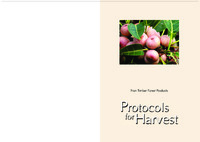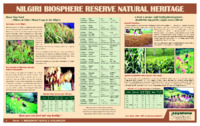Items
Tag
Livelihoods
-
 Protocols for Harvest This resource pack emphasizes sustainable harvesting practices for Non-Timber Forest Products (NTFPs) to balance conservation and livelihoods. It provides guidelines and methodologies for community-based ecological monitoring, incorporating ecological parameters, indigenous knowledge, and traditional practices.
Protocols for Harvest This resource pack emphasizes sustainable harvesting practices for Non-Timber Forest Products (NTFPs) to balance conservation and livelihoods. It provides guidelines and methodologies for community-based ecological monitoring, incorporating ecological parameters, indigenous knowledge, and traditional practices. -
 Millets
Millets
-
 Poster on Millet's The document, seemingly part of a series titled "Indigenous People & Livelihoods," lists various crops and produce with names in a local language, The document is from A GROUP FOR ECO-DEVELOPMENT INITIATIVES, Keystone Centre, Kotagiri, Nilgiris, India.
Poster on Millet's The document, seemingly part of a series titled "Indigenous People & Livelihoods," lists various crops and produce with names in a local language, The document is from A GROUP FOR ECO-DEVELOPMENT INITIATIVES, Keystone Centre, Kotagiri, Nilgiris, India. -
 Tribal Communities-Sustainable Livelihood Options_2002-09-08_Report on Public Hearing on Environment & Development The document presents a report from a public hearing on environmental and development issues in the Nilgiri Biosphere Reserve, focusing on the challenges faced by indigenous tribal communities such as the Todas, Kotas, and Kurumbas. It highlights the impact of migration, modern economic pressures, and environmental degradation on these communities, which traditionally lived in harmony with nature. The report discusses their changing livelihoods, reliance on daily wage labor, and the adverse effects of monoculture plantations on their food security and cultural practices. Additionally, it outlines the efforts of the Keystone Foundation to promote sustainable livelihood options through initiatives like beekeeping, while addressing broader environmental and development concerns in the region.
Tribal Communities-Sustainable Livelihood Options_2002-09-08_Report on Public Hearing on Environment & Development The document presents a report from a public hearing on environmental and development issues in the Nilgiri Biosphere Reserve, focusing on the challenges faced by indigenous tribal communities such as the Todas, Kotas, and Kurumbas. It highlights the impact of migration, modern economic pressures, and environmental degradation on these communities, which traditionally lived in harmony with nature. The report discusses their changing livelihoods, reliance on daily wage labor, and the adverse effects of monoculture plantations on their food security and cultural practices. Additionally, it outlines the efforts of the Keystone Foundation to promote sustainable livelihood options through initiatives like beekeeping, while addressing broader environmental and development concerns in the region. -
 The Honeyhunters of Tamil Nadu-Climbing Through a Period of Change_1995_Forest Trees & People Newsletter no 29 The article explores the lives and traditions of honeyhunters and beekeepers in Tamil Nadu, focusing on their cultural practices, the challenges they face due to modernization, and environmental changes. It highlights the rich diversity of tribal communities engaged in honeyhunting, their historical significance, and the rituals associated with this activity. The authors conducted a survey to document these practices and understand the socio-economic impacts of changing land use and government regulations on these communities. The article emphasizes the need for preserving traditional knowledge while adapting to new economic realities, advocating for support that respects and builds upon the indigenous practices of honeyhunters to ensure their livelihoods and cultural heritage are sustained. This is a newsletter which gives you the details of the honey hunting tech, rituals what they following, uses of the honey and the comb.
The Honeyhunters of Tamil Nadu-Climbing Through a Period of Change_1995_Forest Trees & People Newsletter no 29 The article explores the lives and traditions of honeyhunters and beekeepers in Tamil Nadu, focusing on their cultural practices, the challenges they face due to modernization, and environmental changes. It highlights the rich diversity of tribal communities engaged in honeyhunting, their historical significance, and the rituals associated with this activity. The authors conducted a survey to document these practices and understand the socio-economic impacts of changing land use and government regulations on these communities. The article emphasizes the need for preserving traditional knowledge while adapting to new economic realities, advocating for support that respects and builds upon the indigenous practices of honeyhunters to ensure their livelihoods and cultural heritage are sustained. This is a newsletter which gives you the details of the honey hunting tech, rituals what they following, uses of the honey and the comb.